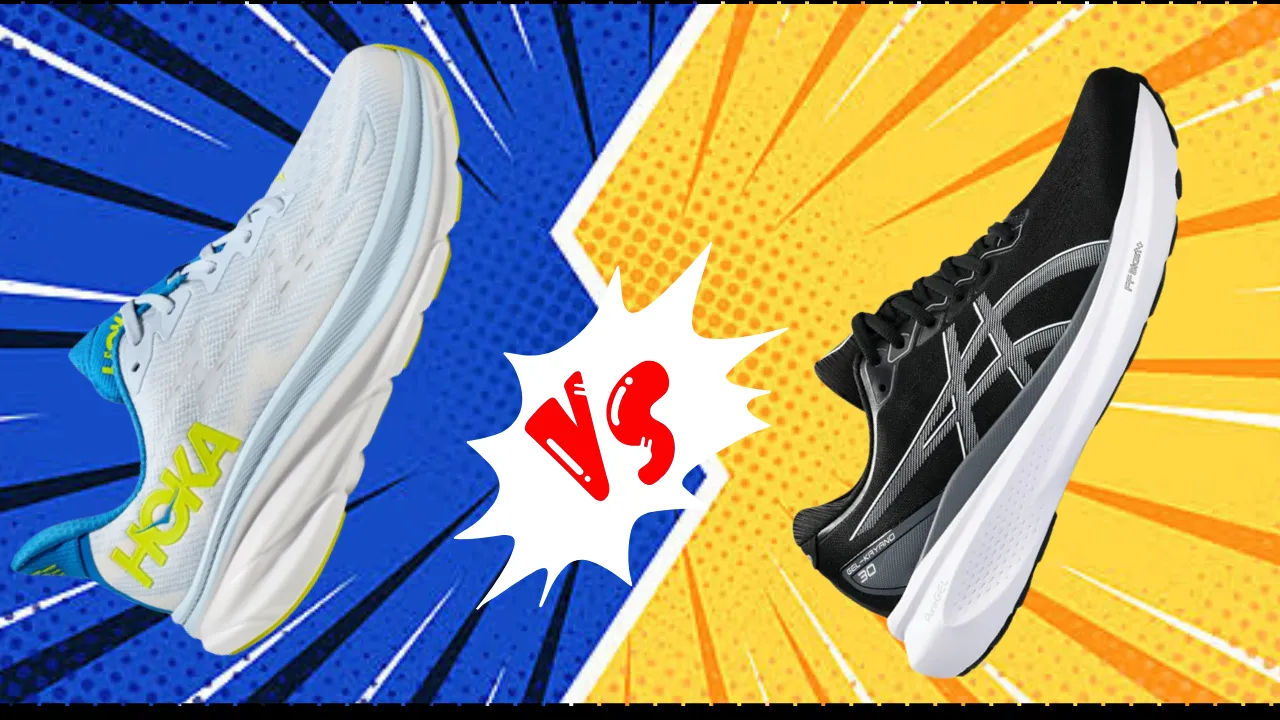The Hoka One One Clifton 9 and Asics Gel Kayano 30 are two of the most popular daily trainers released in early 2023. Both shoes provide soft cushioning and support but differ in their stability features.
This article compares the key specs, materials, performance, and overall value of the Clifton 9 and Kayano 30 to help you decide which one is the better choice for your needs.
Similarities And Differences Between Hoka Clifton 9 And Asics Gel Kayano 30:
| Specs | Hoka Clifton 9 | Asics Gel Kayano 30 |
|---|---|---|
| Launched In | 2023 | 2023 |
| Stability | Neutral | Overpronation |
| Flexibility | Moderate | Moderate |
| Sizing | Men’s 7-15, Women’s 5-12 | Men’s 7-15, Women’s 5-12 |
| Weight | 9.2 oz (M), 7.9 oz (W) | 10.8 oz (M), 9.2 oz (W) |
| Cushion | Maximal | Moderate |
| Outsole | Rubber | AsicsGrip Rubber |
| Midsole | CMEVA Foam | FlyteFoam Blast + DuoMax Support System |
| Upper | Mesh | Mesh + Synthetic Leather |
| Retail Price | $145 | $160 |
Features Comparison
Materials
The Clifton 9 uses a breathable mesh upper with moderate synthetic overlays, while the Kayano 30 combines mesh with more substantial synthetic leather overlays for increased structure and support. Underfoot, the Clifton 9 utilizes a thick CMEVA foam midsole and rubber outsole.


In contrast, the Kayano 30 has a dual-density midsole made of FlyteFoam Blast foam and a firmer DuoMax support system on the medial side to prevent overpronation. It also uses an AsicsGrip rubber outsole. Both shoes have removable insoles.
The Kayano 30 has more stability features through its upper and midsole design to firmly guide and correct overpronation. However, the Clifton 9 provides a softer underfoot feel.
Durability
The outsoles on both the Clifton 9 and Kayano 30 are made of durable rubber that withstands moderate mileage. The Kayano 30’s outsole rubber is branded AsicsGrip, which is known for its traction and longevity. The mesh uppers on both shoes are reasonably sturdy, but the Kayano 30’s leather overlays add more structure for extended durability.
The Clifton 9’s midsole foam retains its cushioning but tends to crease and compress permanently over time. The Kayano 30’s FlyteFoam Blast midsole foam is more resilient and provides consistent cushioning for longer.
Overall, while both shoes can last around 500-600 miles with proper rotation, the Kayano 30 is built with more reinforcement and lasts slightly longer before cushioning or materials degrade. However, the Clifton 9 is the lighter shoe of the two, which can also positively impact durability.
Fit
The Clifton 9 runs true to size for most runners and offers a roomy toe box to accommodate wider feet. Its mesh upper is flexible and non-restrictive. In contrast, the Kayano 30 has a snugger fit in the midfoot and heel due to its synthetic overlays.


It runs true to size for those with narrow to average-width feet. The Kayano 30’s shape and structured upper firmly lock the foot in place to control overpronation, while the Clifton 9’s upper secures the foot without correction.
Underfoot, the Clifton 9’s soft CMEVA foam provides a plush, cushioned feel with low impact. The Kayano 30 has moderate cushioning from its responsive FlyteFoam Blast foam but feels firmer and less forgiving.
The differing fits cater to different preferences – the Clifton 9 for a spacious, cushioned fit and the Kayano 30 for a secure, stability-focused fit. Those needing a wider toe box or softer cushioning may prefer the Clifton 9.
Stability
A key difference between these two shoes is their stability features. The Clifton 9 is a neutral shoe without pronation control, while the Kayano 30 is a stability shoe designed to correct overpronation.
The Kayano 30 uses denser foam on the inside edge of the midsole to prevent the foot from collapsing inward during a foot strike. It also has a structured upper and external plastic heel counter to firmly lock the foot.
In contrast, the Clifton 9 lacks pronation-control features in both its midsole and upper. However, it provides some inherent stability through its wide, well-cushioned base.
Overall, severe overpronators need the motion control of the Kayano 30, while neutral runners can comfortably train in the Clifton 9 without its corrective elements interfering. Mild overpronators could go either way based on preference for a firmer stability shoe or a softer neutral yet stable option.
Cushioning
The Clifton 9 provides substantially softer, more maximal cushioning than the Kayano 30. Its thick, compressive CMEVA midsole foam soaks up impact comfortably across all miles and paces.
In contrast, the Kayano 30 uses a thinner layer of moderate FlyteFoam Blast cushioning with a firmer density medial post. As a result, the Kayano 30 sacrifices plushness for increased stability and support. The Clifton 9 excels at providing ultra-soft cushioning for recovery days, long miles, and easy paces when runners want to save their legs.
The Kayano 30 offers adequate cushioning for daily training while prioritizing a stable ride. However, some overpronators may find the Clifton 9’s highly cushioned platform still effectively absorbs shock without the firmer medial support of the Kayano 30. Both shoes use standard removable insoles.
Value
At their retail prices, the Kayano 30 costs approximately $20 more than the Clifton 9. Both models are premium-priced daily trainers, but the extra stability features of the Kayano 30 account for its higher price point. The durability difference between the two shoes is quite minimal and not enough to justify costing more for the Kayano 30.
In terms of performance, the extra stability and structure of the Kayano 30 is unnecessary for neutral runners who can experience similar training benefits in the well-cushioned Clifton 9 at a lower price.
However, severe overpronators specifically need the Kayano 30’s motion control features to prevent injury during training. For neutral runners seeking an affordable yet versatile daily trainer, the Clifton 9 provides better value for money. The Kayano 30 is a worthwhile splurge solely for runners relying on its pronation correcting abilities.
Performance Comparison
Walking
For walking, the Clifton 9’s extra cushioning and flexibility gives it the edge over the firmer, more rigid Kayano 30. The soft CMEVA foam midsole provides plush step-in comfort at leisurely walking paces, while the Kayano 30’s thinner FlyteFoam can start to feel hard during longer walks.
The mesh upper of the Clifton 9 is also airy and flexible for natural foot movement. In contrast, the Kayano 30’s structured overlays decrease adaptability and freedom of motion during walks. Overall, the Clifton 9 is the better choice for walking comfort.
Running
For straightforward running, the Clifton 9 excels at providing ultra-soft cushioning mile after mile. Its rockered sole also enables smooth transitions.
However, severe overpronators need the Kayano 30’s medial support and motion control elements to prevent injury when running. For milder overpronators, the Clifton 9 still supplies adequate stability through its wide platform while being much softer underfoot.
At faster paces, the firmer Kayano 30 holds up better while the Clifton 9 can start to feel unresponsive. For most neutral runners focused on daily training rather than speedwork, the Clifton 9 is a highly cushioned and comfortable pick.
Plantar Fasciitis
The Clifton 9 is often the preferred choice for runners with plantar fasciitis due to its thick, shock-absorbing cushioning. The soft CMEVA foam midsole protects the feet from worsening irritation and pain caused by impact.
In contrast, the Kayano 30’s thinner foam provides less protection, especially if worn for recovery. However, if overpronation contributes to or exacerbates an existing plantar fasciitis issue, the stabilizing features of the Kayano 30 become necessary to prevent further inflammation. Overall, the Clifton 9 tends to be gentler on inflamed plantar fascia.
Standing All Day
Cushioned shoes are essential for standing all day comfortably. In this case, the Clifton 9 is the clear winner with its plush CMEVA foam that stays resilient even during prolonged standing.
In contrast, the Kayano 30’s thinner FlyteFoam loses its lively responsiveness after hours on your feet and can start to feel flat and hard. The roomier toe box of the Clifton 9 also wins out for accommodating swelling as the day goes on. Overall, the Clifton 9 is an excellent option for occupations that require standing for long periods.
Final Verdict:
For severe overpronators, the Asics Gel Kayano 30 is the better choice for its structured upper and dual-density midsole that provides motion control and stability.
However, most neutral runners receive sufficient support in the well-cushioned Hoka One One Clifton 9. The Clifton 9 also excels as an ultra-soft daily trainer for recovery days and long miles. It provides superior comfort for walking and standing all day at work.
Overall, neutral runners looking for a forgiving yet stable cushioned trainer can save $20 and opt for the excellent Clifton 9 over the Kayano 30. Only those needing pronation correction benefit from the Kayano 30’s features.

